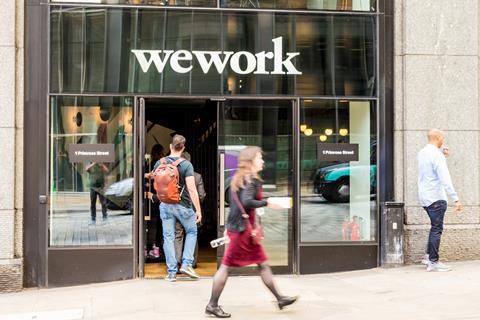It is a crisp September afternoon in 2017. The Office Group (TOG) is opening its new flexible office at the White Collar Factory on Old Street.
Suddenly, a mariachi band appears out of nowhere and starts playing, as people hand out free Mexican food and flyers offering membership discounts. These are not discounts to join TOG, though. They are discounts to join rival co-working company WeWork.
Having ignored the advice of its PR team, WeWork is waging a guerilla marketing campaign against TOG in a bid to nab its clients. Talismanic founder Adam Neumann is reportedly unhappy WeWork lost out to Blackstone in its bid to buy TOG that spring.
“So he hired the burrito vans to park outside TOG to steal clients, apparently because they had rebuffed his offers to buy them,” says a source.
Such tactics have raised eyebrows over the years – as has its cult-like status among members (The Cult of WeWork) – but while the company remained private, nobody really cared how it behaved.
That all changed when WeWork started gearing up to go public. Both Neumann and his business model came under intense scrutiny – and people did not like what they saw.
Cue the triple humiliation of being forced to pull its initial public offering (IPO), having to be bailed out by SoftBank as it came close to running out of cash and Neumann being relegated from chief executive and chairman to “observer”.
Following a three-month investigation, during which we spoke to scores of high-level sources including former WeWork employees, senior agents and a forensic accountant, Property Week can now shed light on some of the factors that fuelled WeWork’s breakneck expansion and paradoxically also contributed to its decline.
We also ask if the $9.5bn (£7.4bn) lifeline that SoftBank threw it last week will return the business to health or just offer a temporary reprieve.
Rapid ascent
WeWork’s valuation has fallen from an eye-watering $47bn to a more modest – and, many would argue, realistic – $8bn in the space of a few months.
That figure is still more than five times the $1.5bn it was worth when it opened its first UK centre, the 37,500 sq ft Sea Containers House, in London in 2014. The site was its first outside the US and marked the beginning of WeWork’s rapid ascent in the UK.
By the end of 2017, it had more than 23,000 memberships across 20 locations, which were all bar one in London – it opened its first Manchester centre in 2017.
That year, it also moved away from a purely leasehold model in the UK to buy two buildings via a complex offshore structure, as Property Week reveals (see boxout below).
Then came a period of exponential, and in hindsight possibly unsustainable, growth. By the end of 2018, it was London’s largest private occupier, operating more than 3m sq ft of flexible workspace – only the UK government occupied more space in the capital. Across the UK and Ireland, it boasted more than 35,000 memberships across 37 locations, including Dublin.
Mega valuation
Since then, these numbers have shot up to 60,000-plus memberships across 58 locations, which now include Edinburgh and Cambridge. A centre in Birmingham has been announced and it has also signed a lease in Glasgow.
Globally, as of June 2019, WeWork boasted 527,000 memberships across 528 locations in 111 cities.

Given its phenomenal rate of expansion, it had long been a question of when and not if the company would float. The answer came this January when WeWork, which by then had been renamed The We Company, filed documents for an IPO in the US.
WeWork’s biggest backer, Japanese conglomerate SoftBank, promptly valued the company at $47bn. Asked to justify the huge valuation, Neumann responded in typically new-age fashion: “The valuation and size today are much more based on our energy and spirituality than it is on a multiple of revenue.”
In August, WeWork published a 383-page prospectus dedicated “to the energy of We”. It was the moment the industry had been waiting for. Now the company had to open its books and offer full transparency of its operations.
“The valuation and size today are much more based on our energy and spirituality than it is on a multiple of revenue”
Adam Neumann, WeWork
That is when the cracks started to appear. Rett Wallace, chief executive of analyst firm Triton Research, described the prospectus as a “masterpiece of obfuscation”.
The document stated that the company’s mission was to “elevate the world’s consciousness” and Neumann’s name was mentioned no less than 169 times. It also came to light that Neumann had sold the name WeWork to The We Company, rented buildings to WeWork that he owned and secured loans from the company.
Investors were not impressed. Within weeks, the company’s valuation tumbled from $47bn to $30bn to $20bn and then, by the time the company was bailed out, to $8bn. Its messianic leader Neumann was put out to pasture, albeit with a consolation $1.7bn pay-off.
Many think Neumann should shoulder most of the blame for the problems at WeWork.
Workplace cult
Echoing the point made in Property Week last year, when we sent an undercover reporter to the company’s annual summer camp, they note that he had created a company that really put the cult into work culture.
One former employee attests to the cult-like ethos on Glassdoor. “[WeWork’s] cultish company culture is being implemented from the top down and quite aggressively so,” reads the review.
“It’s very much a ‘drink the Kool-Aid or you’re out’ type of company. The CEO seems to relish his position of power and assumed position as a modern-day messiah. [There is a] bro-ish and child-like culture despite the focus on ‘community’ and spirituality.”
That ‘bro-ish’ attitude is also something that the sources Property Week spoke to have observed. They claim the mariachi band incident is not the only example of WeWork’s aggressive marketing techniques. Indeed, TOG was reportedly targeted during another launch, when WeWork employees showed up in caravans and private rented cabs, clogging the traffic in the area. This time, they gave away free ice creams alongside the flyers promoting discounted memberships to WeWork.
Agents are, however, reluctant to openly criticise the company’s business model. This is perhaps no surprise when one source claims WeWork has been paying them finders’ fees of as much as 40% for some tenants, with one lucky agent rumoured to have received an eye-watering £1m fee for landing a major ‘enterprise’ occupier.
The sums involved show how high WeWork was prepared to go to secure the buildings and occupiers it needed to fuel its breakneck expansion. Unusually for a serviced office provider, it is happy to take leases of up to 20 years, according to data supplied exclusively to Property Week, while many operators typically look for 10 years. That has allowed WeWork to negotiate longer rent-free periods, which it usually takes up front.
Rent-free periods on some buildings can be as long as 36 months, according to the data, although the average appears to be around 18 to 24 months.
Given that the bulk of the company’s leasing activity has taken place since the third quarter of 2017, many of these rent-free periods are due to expire or have already expired, which could be one of the reasons the company was reportedly running out of cash prior to SoftBank’s rescue.
Special-purpose vehicles

WeWork has another ace up its sleeve in the event that things go wrong. For every building the company leases – or, in some cases, is in negotiations to lease – it creates a limited company, or special-purpose vehicle (SPV), which is a shell company owned by the parent.
WeWork is not the only one to use SPVs. Other flexible workspace operators, such as Regus, have used them to limit their exposure and ‘shield’ the parent companies from financial problems. However, the scale is unusual. According to WeWork’s latest set of accounts filed at Companies House, it has created 65 such vehicles (as of 1 October, it had 58 UK centres).
Thomas White, a partner in the property department of law firm Seddons, explains the benefits of SPVs.
“If the tenant under that lease is an SPV with no other assets, then a landlord is only able to go after that SPV – unless another party has guaranteed the lease in some other way, or there is some form of deposit, bank guarantee or other corporate guarantee in place from the SPV or otherwise,” says White.
Although WeWork is understood to offer a guarantee on such leases, these only tend to last for a short period of time. After that point, if WeWork wants to shutter a poorly trading centre, it can simply hand the lease back to the landlord and the ‘mother ship’ would have some degree of protection.
The use of SPVs is controversial and with other operators, such as IWG, has led to disputes with landlords. It certainly has not endeared the company to the industry.
Many sources also question the ruthlessly efficient desk density in WeWork offices. The company does not disclose its desk density figures, but the sources claim WeWork offers an average desk ratio of 5 sq m per person, compared with the 9.6 sq m of average space per UK worker reported in a 2018 British Council of Offices desk density study.
High density
WeWork defends the high density. “As well as being smart with managing density in our design, WeWork buildings are 2.5 times more efficient with space than a typical office building,” says a spokesperson.
However, the main driver is not efficiency, according to one agent who has worked for WeWork. He says it is chiefly looking to generate a profit margin of at least 40%. “They want to have a very high profit margin so when occupancy rates suddenly drop they can still break even,” he explains.
WeWork also charges its ‘members’ some of the highest desk rates in the flexible workspace sector. As part of the investigation, a few months ago Property Week visited 10 WeWork centres in London to get quotes on a nine-desk space.
One centre offered a 50% discount on the full price of £5,580 plus VAT per month if we signed for 12 months. In other locations, the discount was around 20% for a 12-month deal. We were also told that for every referral we could claim around £1,500 per month as a finder’s fee.
“We have a history of losses and may be unable to achieve profitability at a company level for the foreseeable future”
WeWork IPO prospectus
Indeed, so keen are WeWork agents to sign up members that they even compete with each other, offering prospective members competitive rates for other WeWork centres in the same area. There are “no rules to forbid this”, admits one former agent, who adds that agents are “encouraged to find members wherever they can”.
Another source adds that to keep occupancy levels high, WeWork often offers clients whose contracts are drawing to an end – and who might have already enjoyed discounted or free membership fees – a further discounted or free membership period, potentially in a different building.
The large discounts on offer and high fees paid to agents go some way towards explaining why WeWork has been haemorrhaging money.
In its own prospectus, the company concedes: “We have a history of losses and, especially if we continue to grow at an accelerated rate, we may be unable to achieve profitability at a company level for the foreseeable future.”
WeWork – UK and Ireland timeline
- 2014 WeWork opens first London building
- 2015 The company opens six more centres
- 2016 WeWork has more than 15,000 members across 12 locations in London
- 2017 The company opens its first centre outside the capital, in Manchester. It now has more than 23,000 members in 20 locations
- 2018 WeWork opens a centre in Dublin. By the end of the year, it has more than 35,000 UK and Ireland members in 37 locations
- 2019 New centres open in Edinburgh and Cambridge. WeWork also announces it is opening a site in Birmingham. As of 1 October 2019, it has more than 60,000 members across 58 locations. It has also signed leases or is under offer to take space at another dozen centres in London and Glasgow
Turnaround plan
So what can SoftBank do to turn the company around and make it profitable?
According to one rival flexible workspace operator, the first priority should be to: “Stop taking new leases, take stock of the business and its overheads and make it profitable. Then go again. I think they can turn it into a decent business, but they have to realise that it’s a property business and not a tech business.”

A finance source believes the key will be getting it to “something approaching operational profitability, which means going from a unicorn-chasing tech wannabe to a grown-up business focused on product, service, revenue, operational cost management and eschewing the largesse of the previous CEO and his acolytes.”
The source adds: “At present, for every additional dollar of revenue WeWork gains, it loses something like $1.50, which means there is literally no benefit to WeWork at present in scaling up further.”
For its part, a spokesperson for WeWork says: “We will continue to grow in the UK, but we expect the pace of growth to slow over the next few quarters, and our priority remains to deliver the best-in-class experience for our members.”
Whatever SoftBank decides to do, turning WeWork’s fortunes around will not be easy. The business faces a rapidly growing rent bill as the rent-free periods start to expire. It will also need to consider refurbishing some of the early UK buildings it signed leases on in the next 24 months. Some sources suspect it will shutter some of these buildings rather than splash out on sprucing them up.
“We will continue to grow in the UK, but we expect the pace of growth to slow over the next few quarters, and our priority remains to deliver the best-in-class experience for our members”
WeWork spokesperson
The other major challenge is keeping the company’s remaining employees motivated after the swingeing job cuts. Unsurprisingly, 85% are not happy with Neumann’s £1.7bn pay-off, according to a survey published this week by Recode.
Three months ago, many of these employees had stock options potentially worth millions. Not anymore. Indeed, the only employee who seems to be leaving with a smile on his face is Neumann.
Then again, many would argue that with Neumann, the power of ‘We’ never really could be separated from the power of ‘Me’.
How WeWork uses offshore structures
During the summer of 2017, WeWork acquired its first freehold buildings in London.
The two office blocks, at 51 Eastcheap and 120 Moorgate, were bought just over a month apart using the same offshore structure, Property Week can reveal.

WeWork and US private equity firm Rhone Group set up two companies in Luxembourg called Eastcheap SA and 120 Moorgate SA, which own the buildings. The two Luxembourg companies are themselves owned by a Cayman Islands-registered company, WeWork Property Investors Operating Partnership III.
Ronen Palan, a professor of international politics at City, University of London, and an expert in offshore jurisdictions, says this type of ‘double structure’ is usually set up for tax and confidentiality purposes.
“If you sell the property in London, you would have to pay capital gains tax and the buyer would have to pay stamp duty,” says Palan. However, in Luxembourg the company has to pay minimal taxes and in the Caymans, no tax.
What is also interesting about the buildings is their book values. The 86,000 sq ft 51 Eastcheap was acquired on 27 July for £47m, while the 156,000 sq ft 120 Moorgate was acquired on 6 September for £43m. WeWork’s accounts state that by the end of 2017, the properties were worth £56m and £59m, up 19% and 37% respectively.
Roger Isaacs, a forensic accountant at Milsted Langdon and national technical director of the Network of Independent Forensic Accountants, says: “One of the things that might justify this hike in value would be if the buildings had been vacant when they were initially acquired and they subsequently secured a good-quality tenant after the acquisition.”
“If you own a property and then you enter into a lease with a shell company that you own and have incorporated for the purpose, that would almost certainly not justify a large increase in value because the shell company would have no financial standing to meet the lease commitments on its own”
Roger Isaacs, Milsted Langdon
WeWork is the sole tenant at 51 Eastcheap, having signed a lease two days after completing the purchase, according to Land Registry filings. At 120 Moorgate, it is one of two tenants and currently refurbishing the space leased by the other: Barclays Bank.
Isaacs does not think this would account for the significant uplift in the value of the buildings.
“If you own a property and then you enter into a lease with a shell company that you own and have incorporated for the purpose, that would almost certainly not justify a large increase in value because the shell company would have no financial standing to meet the lease commitments on its own,” he explains.
Palan says that a change in fair value is usually done with a future sale in mind.
“We call this structure ‘opportunity spaces’,” he says. “You anticipate changes in rules, avoid UK tax and inflate the price by immediately increasing the asset’s value. You tell investors: ‘We bought it for £43m but we were clever and it’s actually worth £59m.’”
WeWork declines to comment on the ownership structure of the buildings. Rhone Group also declines to comment.






























No comments yet